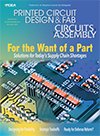ROI
 With planning, the integrated supply chain can overcome the negative impacts.
With planning, the integrated supply chain can overcome the negative impacts.
It’s a small world after all, the saying goes. Ain’t that the truth!
For decades those of us in the electronics industry, and particularly those closely involved in the technology, have experienced the many changes and benefits a truly global economy can create and offer. Time was, an ocean, time zone or culture may have made integrated product development and manufacturing difficult and costly, if not totally impossible to achieve. Those days are long gone. And yet today it’s the norm that global companies – or consortia– work almost seamlessly together to bring to market the next cutting-edge, technology-rich, and most of all, cost-effective “must have” new product.
The evolution of the global supply chain involved many phases. First, parts, components, supplies and raw materials could be made in locations that offered either the lowest cost or the most advantageous transportation/distribution alternatives, or be where either the raw materials or end-customers were located – all of which resulted in the most cost-effective value. The evolution continued where R&D began taking place in different parts of the globe, which enabled different cultures and engineers in different end-user markets to incorporate the features, benefits and attributes sought by those different demographics into basic design. That led to a reduction of engineering costs to modify newly developed products to become truly universally successful. In turn, people from all over the world with different cultural backgrounds, different economic statuses and different educational levels began to work together and become friends. When people get to know each other, learn to appreciate and trust each other, and share common dreams and goals, the world truly seems smaller.
 Are otherwise global companies putting all their R&D eggs in one basket?
Are otherwise global companies putting all their R&D eggs in one basket?
Buying cars is not what it used to be. I was recently kicking the proverbial tires in search of a new automobile. This was the 18th time I underwent this process, one I approached with mixed emotions. It’s always interesting to see what new technology, appearance and driving experience has been packed around an engine riding on four tires. Yet it’s also concerning, as the cost always triggers a rethink of my priorities and change in my expectations.
This time around, the two biggest areas of technological interest also provided the greatest areas of concern. One was the lack of familiar knobs, dials and gauges. For the seasoned driver, this can cause initial, if not ongoing, confusion while navigating heat, air conditioning, music, and all the other things cars can do. The second was the lack of a spare tire. Many cars (or their manufacturers) are being touted as so reliable, spare tires are no longer necessary. Just deploy the tire repair/inflator (if you can find it on the knob-less dashboard) and away you go.
 New industries outside electronics may have different products, but share a familiar approach.
New industries outside electronics may have different products, but share a familiar approach.
Last February, at the same time and place as IPC Apex Expo, maybe you noticed the signs for something called “Traffic & Conversion 2018.” Perhaps it was my age, or perhaps just naivety, but I just assumed the event dealt with roadway equipment used to manage vehicular traffic. Boy was I wrong.
Had I focused on the attendees, I would have immediately noticed that virtually all of them were young and tethered to their iPads. Over their morning coffee at Starbucks, there was no conversation or early morning banter. Instead, everyone was in a trance, staring at their screens. At night, the same youthful attendees held court at the bar, laughing and networking. During a conversation with one, I finally learned what the group was all about. “Traffic & Conversion” was really an annual pilgrimage by data geeks to learn the latest trends, technology and methods employed in the world of “data mining.”
 Not everyone is. That’s a mistake.
Not everyone is. That’s a mistake.
It hit me while walking through IPC Apex Expo in February. Talking with various colleagues, the famous quote from A Tale of Two Cities kept repeating in my head: “It was the best of times, it was the worst of times.”
At every industry meeting I have been to in recent months, the mood has been quite bullish, reflecting the best of times. The HKPCA Expo in Shenzhen was well-attended, and money was being spent – lots of it! Ditto for Apex, where attendance appeared brisk and North American companies were in a buying mood. Discussions revolved around adding capacity, further incorporating higher technology capability, and exciting new customer relationships – all of which overshadowed the news that tariffs and trade restrictions could be in the offing.
 Don’t be deceived into thinking your company is running smoothly.
Don’t be deceived into thinking your company is running smoothly.
Running a business, I have learned, is full of paradoxes. There are tasks that may be simple but not easy to do. There are tasks that are easy to do but not necessarily simple. And there are tasks that start off looking easy and simple but end up just confusing. Toughest of all, however, is remaining focused on what is critical to success. Focus too often starts off appearing both easy and simple, but then morphs into such chaos that one forgets what they were trying to accomplish in the first place – and why. At such times managers need to remember that no matter the type of initiative (simple, easy, focused, confusing), success boils down to best utilizing the invaluable three Ts: Treasure, Talent, and Time.
Treasure may seem obvious, yet when undertaking a new initiative it is often the most underestimated resource. Yes, everyone knows how to calculate the cost to purchase needed equipment and materials. And it is true those all around you (especially above) will hammer away to make sure every penny is accounted for and every penny of return is realized. What is more often than not underestimated, however, is how much treasure is required to make it through those rainy days caused by anything from a bad month to a lost customer to an economic downturn.


